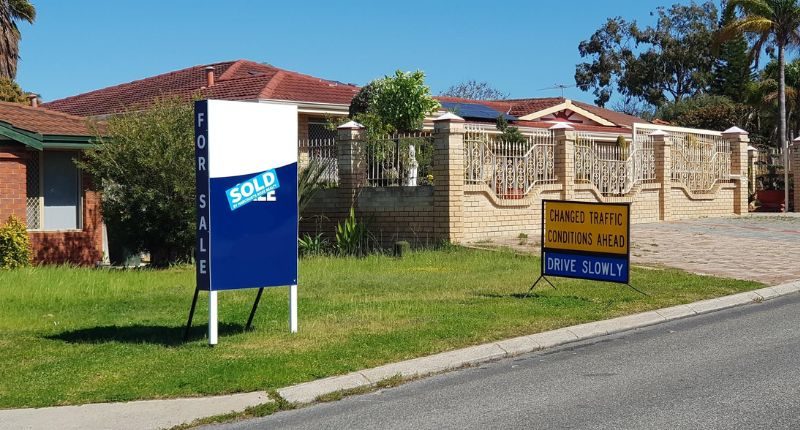
- Eight consecutive rate rises brought rates to 3.10% in December 2022
- 2022 started with a cash rate of 0.1%
- House price falls beat previous records set between 2017 and 2019
Today, CoreLogic released data that found house values fell at a record rate.
According to the CoreLogic Daily Home Value Index (HVI), house prices fell by 8.40% on 7 January 2023, after peaking in early May last year.
The previous record was a fall of 8.38% between October 2017 and June 2019, with the latest housing downturn playing out in less than nine months.
CoreLogic said one of the reasons for the house price plummets includes the rampant rate rises across 2022.
The eighth monthly cash rate rise struck in December last year, with the Reserve Bank of Australia (RBA) bringing the official cash rate from 2.85% in November to 3.10%.
“In addition to constrained borrowing capacity, higher interest costs may be dissuading potential buyers altogether,” said CoreLogic’s Head of Residential Research Australia, Eliza Owen.
PropTrack’s latest Home Price Index likewise put the house price slump down to interest rate rises, noting:
“The borrowing power of the average buyer has been slashed by around 25% due to the cumulative impact of … rate rises.”
PropTrack Home Price Index, 3 Jan 2023
PropTrack’s latest report shows data up until December 2022, with a national house price decline of 0.21% recorded across December, and a 2.29% decline year on year.
The capital cities had a combined December fall of 0.22%, with all capitals across Australia except Darwin and Hobart recording falls – indeed Adelaide saw its first monthly price decline post-pandemic, down 0.18%.
Australia saw the largest price declines occur across the east coast, with Canberra recording the largest drop of 0.43%, and Melbourne close behind at 0.34%.
Perth has long been tipped to buck the property downturn trend, and the latest data continues to show just that. While the western capital recorded a monthly decline of 0.05%, annual growth increased 3.61%.
Having said that, annual growth was recorded across most cities, barring Australia’s largest cities: Sydney and Melbourne, which recorded annual growth of -6.99% and -5.16% respectively.
| Region | Monthly growth (%) – All dwellings | Annual growth (%) – All dwellings | Median value ($) – All dwellings | Change since peak (%) – All dwellings | Peak month – All dwellings |
| National | -0.21 | -2.29 | 739,000 | -4.25 | Mar 2022 |
| Capital Cities | -0.22 | -3.99 | 788,000 | -5.18 | Mar 2022 |
| Regional Areas | -0.17 | 2.08 | 619,000 | -2.37 | Apr 2022 |
| Sydney | -0.19 | -6.99 | 989,000 | -7.23 | Feb 2022 |
| Rest of NSW | -0.14 | 1.15 | 715,000 | -2.9 | Apr 2022 |
| Melbourne | -0.34 | -5.16 | 802,000 | -5.96 | Mar 2022 |
| Rest of Vic. | -0.13 | -0.02 | 595,000 | -3.02 | Apr 2022 |
| Brisbane | -0.18 | 2.18 | 716,000 | -3.2 | Apr 2022 |
| Rest of Qld | -0.33 | 3.86 | 612,000 | -2.42 | Apr 2022 |
| Adelaide | -0.18 | 9.63 | 646,000 | -0.21 | Oct 2022 |
| Rest of SA | 0.12 | 14.24 | 374,000 | 0 | Dec 2022 |
| Perth | -0.05 | 3.61 | 560,000 | -0.23 | Aug 2022 |
| Rest of WA | 0.33 | 5.18 | 444,000 | 0 | Dec 2022 |
| Hobart | 0.11 | -0.04 | 701,000 | -2.47 | Apr 2022 |
| Rest of Tas. | -0.11 | 4.75 | 492,000 | -0.68 | Sep 2022 |
| Darwin | 0.32 | 1.38 | 499,000 | -0.22 | Jun 2022 |
| Rest of NT | 0.2 | 6.08 | 450,000 | 0 | Dec 2022 |
| ACT | -0.43 | -2.6 | 847,000 | -5.05 | Mar 2022 |
Source: PropTrack Home Price Index, 3 January 2023.
Dwelling approvals drop for third month in a row
New Australian Bureau of Statistics (ABS) data was released today, with building approvals found to have fallen by 9% during November, in seasonally adjusted terms.
This follows a 5.6% decrease in October.
“The result was driven by private sector dwellings excluding houses, which decreased 22.7 per cent. Approvals for private sector houses fell by 2.5 per cent,” said Daniel Rossi, ABS head of construction costs.
“The November result is the third consecutive month of declines for total dwelling approvals, having fallen 21.7 per cent since August.”
The total number of dwellings approved fell:
- 18.4% in NSW,
- 17.5% in WA,
- 12.7% in Victoria, and
- 5.6% in Queensland.
In contrast, housing approvals increased by 75.7% in Tasmania and 10% in South Australia.
The data also revealed that the value of total building approvals fell 1.5% in November, following a 0.4% decrease in October.
The value of total residential building approvals fell 4%, thanks to a 3.1% decrease in new residential buildings and a 9.2% decrease in alterations and additions.
Despite this, the value of non-residential building approved stayed strong, increasing 2% in November, following a 2.3% rise in October.












